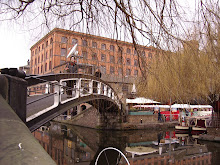Bejar, my home town, was an
industrial centre in the past located in the west of Spain, with a thriving
textile industry pre-dating even the Industrial Revolution.
Since
ancient times, the town was characterized by its dedication to wool production,
an activity which flourished after the arrival of the Flemish Masters in the
late seventeenth century (1691). The Flemish Masters were experts in textile
production and they were brought by the Duke of Bejar to drive the development
of the industries here. Thus, the great development and improvement of the
textile industry, which characterized the economy in Bejar during the
nineteenth and twentieth centuries, is explained.
Industrial
development favoured and consolidated Bejar’s middle class, which during the
nineteenth century controlled Bejar’s policy, once the Duke of Bejar’s
privileges disappeared.
In
the first half of the twentieth century, the outbreak of the Spanish Civil War
benefited Bejar’s industry, since Bejar stood at the “national area” in
opposition to “republican” Catalonia.
The military victory established a strong connection between the new
regime and Bejar’s middle class. Then its industry obtained the supply of
clothing for the army.
 |
| Old factories, the old railway and the river |
The
1970s meant the beginning of the end of the clothing industry. The decline of
the clothing industry in Bejar was the result of the excessive dependence on
the state contracts, poor location, the loss of the railway, poor
communications..., (many factors have been analysed in order to explain the
decline, but not even experts agree),
which made it very difficult to compete in the globalized world. Around
1849 there were 200 factories employing 4,000 people; in 1969 there were 58
clothing companies and 38 craft workshops with about 3,500 workers. Nowadays
there are about 14 companies in Bejar employing about 300 workers.
As
a result of the industrial decline, the town has lost population progressively
since the 70’s, when Bejar was close to reaching 18,000 inhabitants. The
situation is progressively getting worse and worse and according to 2011
official statistic figures, the population is less than 15,000 inhabitants,
14,511 (INE).
In
short, economic depression, loss of population, unemployment, low wages, lack
of opportunities for young people, brain drain, lack of entertainment..., Bejar
has become a sad, tired and dirty old town.
There
is a popular British folk song entitled “Dirty Old Town”. I don’t know why but
this song always evokes me Bejar, even before I could understand the lyrics,
probably due to its title. I knew this song through the version by The Pogues,
an Irish band, but I found with surprise that this is not the original one.
“Dirty Old Town” was written By Ewan MacColl, British folk singer and social activist,
in 1949 but was made popular by The Dubliners, amazing Irish folk band, and has
been covered by many others since, especially Irish bands. Thus, there is a
common misconception that the song is Irish and was written about Dublin.
However, the song was written about Salford, MacColl’s hometown, so the song
actually originates from northern England.
The
song is about a love and hate relationship with the town. Dirty and old,
in fact, denote disgust and repulsion. Nevertheless, the town is the setting
for the romance which is taking place in it, too. The song also evokes sounds,
images and places related with industry, like factories, canals, sirens,
trains, smoky wind... However, the last verse is reserved for some kind of act
of rebellion towards the city, envisaging its destruction. In the last part of
the verse, there is a change from an authorial “I” to “we”. It is
not clear if this plural subject refers to the couple or to the collective of
citizens or workers, who will chop down a “you” – I’ll chop you down
like an old dead tree- that might be the town itself or one of its
architectonical features (chopping down like a tree might refer to the
tall chimneys of the factories).
Recognizing that cases
are not exactly alike, Bejar has become a grim town like the Dirty Old Town
described by the song. Nowadays in Bejar most of the factories are closed,
destroyed or have become shopping centres or blocks of flats. Many places
remind of the industrial past like chimneys, canals, the train track, train
station..., but all these places are abandoned, the sirens don’t sound, there
are no trains, no smoky wind..., and there is no future.
Listen to the version by The Dubliners, live. Click here.
The photos for this entry has been taken from the blog by Mª del Carmen Cascón.
This is a fantastic entry, Fernando, it's obvious you've worked hard. Congratulations!
Ok, guys, what are you waiting for? Start leaving your comments on it.



No hay comentarios:
Publicar un comentario